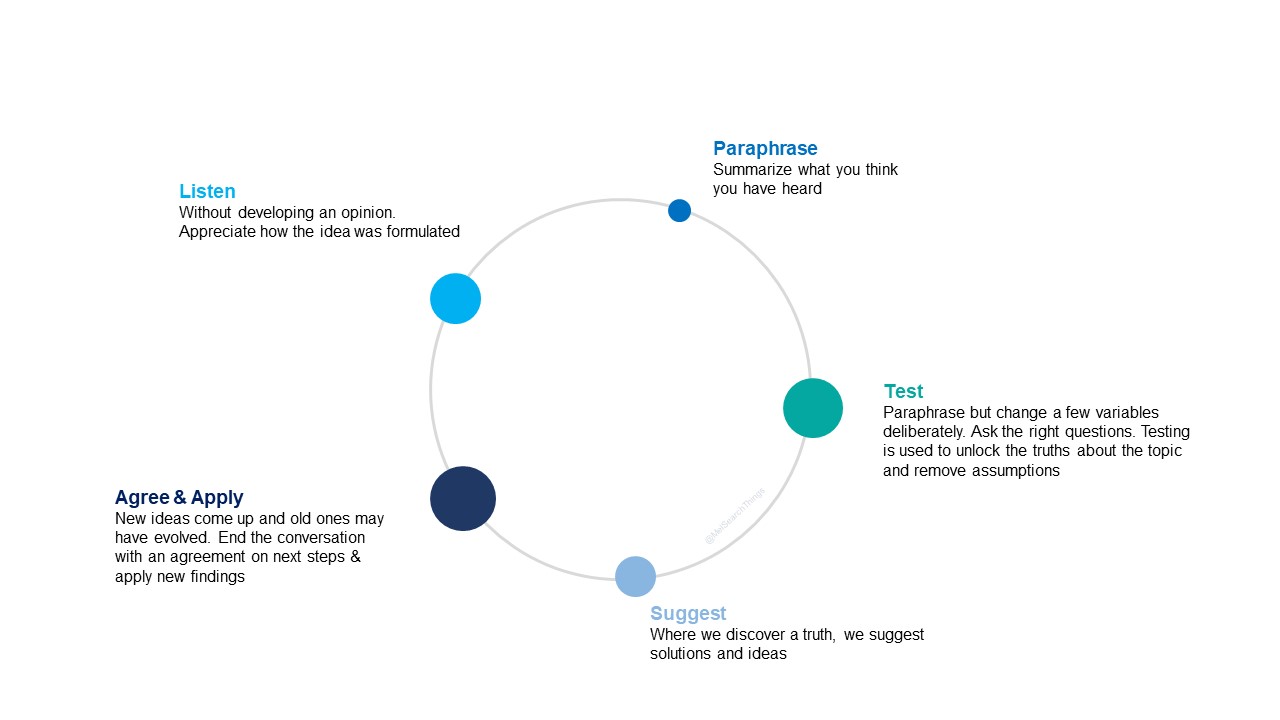Communication is what we do as marketers and as human beings. It’s the heart of how we relate to each other and create trust. Having a communication model you trust can make a world of difference to client satisfaction and longevity.
“Not happy with communication” ranks as a top reason clients leave agencies or partners. Good communication aims to unlock value and remove ambiguity from all stakeholders.
The 2018 Salesforce “State of Service” report found that 80% of customers say the experience a business provides is just as important as their product or service – a number that’s not likely gone down since.
In my nine years formulating digital media solutions for clients from many verticals, including travel, finance, automotive, retail, pharma, electronics, entertainment, and CPG, this 5-step framework helped me communicate with purpose and achieve maximum potential gains with my clients and teams:

Step 1: Listen
As marketing experts, it is very tempting to start formulating solutions and judgments while expressing the task or idea. Practice active listening without judging or developing an opinion.
Appreciate how the idea was formulated. Lastly, pay attention to your client’s body language; what are people telling you with their eyes or facial expressions?
Step 2: Paraphrase
Repeat & summarize what you think you have heard. This ensures you understand the task and gives the client a chance to confirm or offer additional information.
Step 3: Test
Paraphrase but change a few variables deliberately. See if the result of the paraphrase is consistent. Testing ensures no unmissed subtleties and helps remove ambiguity. It is also used to unlock the truths about the matter.
This is also your chance to ask questions. We ask questions to learn and create connections. Asking the right questions will cut through the clutter, find the argument’s weaknesses, and get a new sense of direction or insights.
It should reveal someone’s motivation and shed light on the end goal.
Simple and direct questions usually get you the best answers. Often, people end up rambling or derail from the question, so it is crucial to be persistent and patient while holding them accountable.
Step 4: Suggest
Use the facts you learned from the previous step to know where the opportunity is and what the client wants to do. This is the opportunity to let your expertise and professionalism shine.
Use the information you’ve gathered from the test phase to make the most efficient & effective recommendation to meet client goals.
Step 5: Agree & Apply
At the end of the conversation, ideas may have shifted, and new concepts evolved. End the conversation with an agreement. The agreement is now in place, so apply any new findings immediately.
Let’s look at this in an actual example and see the five steps in action:
Example
It’s a Thursday afternoon, you are near the end of a client WIP. You are about to wrap up, and the main client suddenly asks for a bunch of stuff.
“We have a few promotions going on, and I want to support them with some paid search activity. The previous manager said to follow the set up of old campaigns, and I want it to go live tomorrow morning.”
Now let’s try the five steps.
Step 1: You perform active listening, despite happy hour starting, and you smell the hors d’oeuvre from the community area.
You nod your head make eye contact while giving short verbal confirmations like “I see .”Read the client’s body language. What are they communicating with their face, their arms? Are they closing off or opening up?
Step 2: Paraphrasing can look or sound like:
- I see you want to support the current promotions with paid search. Are there four offers that are going on right now?
- You want the campaign to follow the same format as previous sales and go live tomorrow morning.
Step 3: Test
Switch up a few variables in the form of either statements or questions:
- What does success look like? You will be happy if we drove x traffic/revenue via paid search
- Do you want to target the whole DMA?
- Do you want to boost our ad spend by 20%?
- What kind of messaging?
- When you said the previous format, do you mean X?
- Which ones do I prioritize?
- How long does the promotion run for? (Explore the urgency of the request)
- Based on the last campaign, we have these learnings.
While the client relies on our expertise to know the answers to their problems, it is always a better experience when you ask questions to spark the client’s thinking and make them feel like they are forming the solution with you.
Step 4: Suggest
“It sounds like promotion X is the most important. Based on the data from the last sale, I know that the peak revenue happens one week after the promo goes live.”
“Let’s prioritize this tactic, use x audience strategy, and go live with a phased approach. Instead of targeting the whole DMA, why don’t we focus on a few geographies that are our highest selling?”
Step 5: Agree & Apply
Once you align on the plan & next steps, send a follow-up email to recap.
The end goal is that the client should feel like you understand who they are, their business, and what they need to succeed. Often, the client might not even know what they want.
But we, as search experts, can hear what they want, know how to execute strategically, ensure we are on the same page, and finally put it into action.
Use this framework to position yourself as a trusted partner and advisor who can help them solve the problem.
This is a guest post.
About Melissa:
With over 9 years of experience in paid search marketing & having worked in and developed performance media solutions in the USA, New Zealand, Australia, and China, Melissa offers valuable insights across countless markets and verticals. Her exceptional ability as an artist also helps her to inject creativity into a specialism that can often be mechanical. She specializes in unique opportunities to drive business growth by connecting data with creativity and bringing performance strategies to life. Melissa currently works at RPA, an independent LA-based advertising agency.











